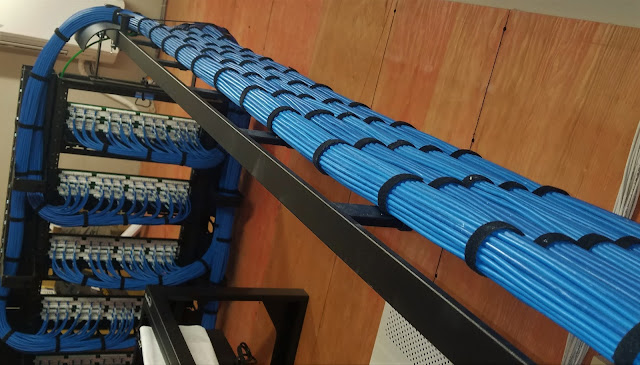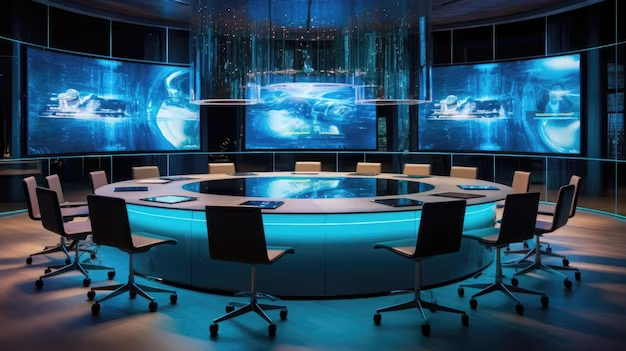Designing for Diversity with Audio Video Integrators in Multifunctional Spaces
In today's dynamic work environment, Multifunctional Spaces have
emerged as a cornerstone of the workplace, reflecting the Growing Trend of
Flexible Workspaces. These versatile areas seamlessly accommodate diverse
activities, from collaborative meetings to interactive presentations. The
Importance of Seamless Audio Video Integrators
in such spaces cannot be overstated. As organizations embrace flexibility, the
ability to transition effortlessly between functions becomes a key determinant
of efficiency and productivity.
Challenges in Multifunctional Spaces
Varied User Requirements
Multifunctional Spaces cater to a spectrum of user needs, ranging from
team collaborations to solo tasks. Ensuring that the audio-video setup meets
these diverse requirements poses a significant challenge for organizations
seeking a harmonious balance.
Space Constraints
Often, these spaces grapple with limitations in terms of size or
structural design. Integrating comprehensive audio-video systems within these
constraints necessitates creative solutions to optimize functionality without
compromising aesthetics.
Technology Compatibility
The coexistence of various audio and video devices from different
manufacturers can lead to compatibility issues. Overcoming these hurdles
requires careful planning to seamlessly integrate diverse technologies into a
cohesive system.
Acoustic Considerations
Achieving optimal audio quality in multifunctional spaces is hindered
by factors like varying room sizes and differing acoustic needs. Implementing
effective acoustic solutions is pivotal to delivering a superior audio
experience across diverse configurations.
User Interface Complexity
The multifunctionality of these spaces can result in a complex user
interface, making it challenging for individuals to navigate seamlessly between
different modes. Simplifying the user experience is essential for maximizing
the effectiveness of these spaces.
Modular AV Systems: A Flexible Approach
Explanation of Modular AV Systems
Modular AV Systems provide a dynamic solution, allowing organizations
to adapt their audio-video setups based on specific needs. These systems
consist of interchangeable components that can be easily configured to support
different functions.
Benefits in Multifunctional Spaces
The flexibility offered by Modular AV Systems aligns perfectly with
the versatile nature of multifunctional spaces. Whether transforming a room for
a collaborative meeting or a solo task, organizations can optimize their
audio-video infrastructure to suit the current requirement.
Leveraging Wireless Connectivity
Role of Wireless Technology
In the realm of Multifunctional Spaces, the Role of Wireless
Technology is transformative. Wireless connectivity liberates these spaces from
the constraints of traditional wired setups, allowing for greater flexibility
in configuring the room for different purposes. It fosters a dynamic
environment where technology seamlessly adapts to the evolving needs of the
users.
Wireless Presentation Systems
Wireless Presentation Systems epitomize the freedom of movement and
collaboration. These systems enable users to share content effortlessly from
their devices to a central display, eliminating the need for cumbersome cables.
This not only streamlines presentations but also enhances the overall
collaborative experience within multifunctional spaces.
Wireless Audio Solutions
The advent of Wireless Audio Solutions further contributes to the
adaptability of these spaces. Whether it's a team meeting or a solo
brainstorming session, wireless audio systems offer the freedom to position
speakers strategically, ensuring optimal sound quality throughout the space.
This flexibility enhances the overall auditory experience for users.
Enhancing Flexibility and Mobility
By embracing Wireless Connectivity, audio-video integrators empower
users with unparalleled Flexibility and Mobility. The ability to connect and
collaborate wirelessly fosters a dynamic environment, allowing users to move
freely and interact with technology seamlessly. This not only improves user
experience but also contributes to the efficiency of multifunctional spaces.
Automation and Control Systems
Simplifying User Experience
Automation and Control Systems are instrumental in Simplifying the
User Experience within multifunctional spaces. These systems provide intuitive
interfaces that allow users to control various audio-video components
effortlessly. A user-friendly interface ensures that individuals, regardless of
their technical expertise, can navigate the technology seamlessly.
Pre-programmed Settings for Different Modes
To further streamline operations, audio-video integrators can
implement Pre-programmed Settings for Different Modes. This means that the
multifunctional space can be pre-configured for specific activities, such as
meetings, presentations, or training sessions. Users can switch between modes
with a single command, optimizing the space for their current needs.
Integration with Smart Building Systems
In the era of smart buildings, Integration with Smart Building Systems
is pivotal. Audio-video integrators can sync their systems with broader smart
building ecosystems, allowing for centralized control and monitoring. This
integration not only enhances efficiency but also contributes to a more
sustainable and connected workspace.
Acoustic Treatments for Optimal Audio
Importance of Acoustic Considerations
In the pursuit of Optimal Audio, Acoustic Considerations play a
critical role. The unique challenges presented by multifunctional spaces, such
as varying room sizes and configurations, require a tailored approach to
acoustics. Integrators must prioritize solutions that address these challenges
while preserving audio quality.
Sound-Absorbing Panels
Implementing Sound-Absorbing Panels is an effective strategy to
mitigate acoustic challenges. These panels absorb sound waves, reducing echoes
and minimizing disruptions caused by ambient noise. Strategic placement of
sound-absorbing panels contributes to a more controlled and comfortable audio
environment.
Speaker Placement Strategies
Strategically placing speakers is an art in itself. In multifunctional
spaces, where the layout can change frequently, audio-video integrators must
employ Speaker Placement Strategies that ensure consistent and high-quality
sound reproduction. This may involve adjustable mounting systems or the use of
multiple smaller speakers for more even coverage.
Maintaining Audio Quality in Varied Configurations
Maintaining Audio Quality in Multifunctional Spaces requires a
holistic approach. Integrators must account for the diverse configurations the
space may adopt and implement solutions that ensure a consistent and immersive
audio experience. This might involve the use of adaptable speaker systems or
advanced audio processing technologies.
Integrated Furniture and AV
Benefits of Furniture with Built-in AV Components
The fusion of furniture with audio-visual components brings forth a
myriad of Benefits. This innovative approach not only maximizes space
utilization but also enhances the overall functionality of multifunctional
spaces. Furniture with Built-in AV Components seamlessly integrates technology
into the environment, offering a sleek and uncluttered aesthetic while
providing essential features for presentations, collaborative work, or solo
tasks.
Space-Saving Solutions
Integrated Furniture and AV solutions offer Space-Saving Solutions
that are particularly valuable in compact multifunctional spaces. By embedding
audio-visual components within furniture pieces, organizations can optimize
room layouts, ensuring every square foot serves a purpose. This streamlined
approach is especially beneficial in settings where space is at a premium.
Maintaining Aesthetics in Design
The challenge lies not only in functionality but also in maintaining
Aesthetics in Design. Audio-video integrators must strike a delicate balance
between technological capabilities and design harmony. Integrated furniture
solutions should seamlessly blend into the overall design scheme, enhancing the
visual appeal of the space without compromising its primary purpose.
User Training and Support
Significance of User Training
Recognizing the Significance of User Training is crucial for the
successful adoption of audio-visual systems in multifunctional spaces. Proper
training ensures that end-users are proficient in operating the technology,
reducing the likelihood of errors and increasing overall efficiency. Training
sessions should cover basic operations, troubleshooting, and any customized
features specific to the organization.
Ongoing Support Mechanisms
Beyond initial training, Ongoing Support Mechanisms are essential.
Audio-video integrators should establish support channels to address user
queries, technical issues, or system upgrades. Timely assistance contributes to
a smoother user experience, fostering confidence in the technology and
encouraging its optimal use within multifunctional spaces.
Reducing User Interface Complexities
A key focus of user training and ongoing support is Reducing User
Interface Complexities. Integrators should design intuitive interfaces that
minimize the learning curve for end-users. Streamlined control systems and
straightforward commands contribute to a user-friendly experience, eliminating
unnecessary complexities that may hinder efficient use of audio-visual systems.
Flexible Display Solutions
Role of Flexible Displays
Flexible Display Solutions play a pivotal role in enhancing
adaptability within multifunctional spaces. These displays offer the
flexibility to adapt to different room layouts and functions seamlessly.
Whether it's a collaborative meeting requiring a large display or a focused
solo task with a smaller screen, flexible displays cater to the dynamic nature
of these spaces.
Motorized Screens and Retractable Solutions
To further augment flexibility, Motorized Screens and Retractable
Solutions are invaluable. These features allow displays to be concealed when
not in use, preserving valuable wall or floor space. The ability to retract
screens or adjust their position with motorized mechanisms adds a layer of
adaptability to the audio-visual setup.
Adaptation of Room Layout and Function
The ultimate goal of Flexible Display Solutions is to facilitate the
Adaptation of Room Layout and Function. Audio-video integrators should design
systems that can seamlessly transform a space, whether from a presentation
setup to a collaborative meeting configuration. This adaptability ensures that
the audio-visual components align with the evolving needs of the users.
Centralized Control Systems
Streamlining AV Operation
Centralized Control Systems play a pivotal role in Streamlining AV
Operation within multifunctional spaces. By consolidating the control of
various audio-visual components into a single interface, users can effortlessly
manage different devices without the need for multiple remotes or complex
setups. This streamlining not only enhances operational efficiency but also
contributes to a more user-friendly experience.
Single Interface for Multiple Components
A key feature of Centralized Control Systems is the provision of a
Single Interface for Multiple Components. Users can control displays, audio
systems, lighting, and other AV elements seamlessly from one centralized
platform. This unified approach simplifies the user experience, reducing the
potential for confusion and errors in operating diverse AV equipment.
Enhancing User Control and Experience
Centralized Control Systems go beyond mere convenience; they are
instrumental in Enhancing User Control and Experience. The ability to customize
settings, switch between different modes, and adjust audio-visual parameters
from a centralized interface empowers users, ensuring they have the flexibility
to tailor the technology to their specific needs.
Future Trends in Audio-Video Integration for Multifunctional Spaces
Emerging Technologies
The future of Audio-Video Integration for Multifunctional Spaces holds
exciting possibilities with Emerging Technologies. Advancements such as
augmented reality (AR), virtual reality (VR), and AI-driven integration are on
the horizon. These technologies aim to further blur the lines between the
physical and digital realms, offering immersive and interactive experiences
within multifunctional environments.
Predictions for the Evolution of AV Systems
Predicting the Evolution of AV Systems involves anticipating trends
that will shape the landscape. The integration of AI for predictive
maintenance, gesture-based controls for touchless interactions, and enhanced
connectivity for seamless collaboration are among the predictions. As
technology continues to advance, audio-video integrators must stay abreast of
these trends to offer cutting-edge solutions.
Recap of Challenges and Solutions
In conclusion, we recap the Challenges and Solutions discussed
throughout the article. Integrating audio-visual systems in multifunctional
spaces presents various challenges, from diverse user requirements to the
complexities of technology compatibility. However, solutions such as modular AV
systems, wireless connectivity, and centralized control mechanisms offer
effective ways to overcome these challenges.
Frequently Asked Questions (FAQs)
How can modular AV systems adapt to the diverse needs of users in
multifunctional spaces?
Modular AV systems offer flexibility by allowing users to customize
their audio-visual setup based on specific requirements. Components can be
added or removed easily, accommodating varied needs for presentations,
collaborative work, or entertainment within the same space.
What role does wireless connectivity play in audio-video integration,
and how does it enhance flexibility in multifunctional environments?
Wireless connectivity eliminates the need for physical cables,
providing a clutter-free environment in multifunctional spaces. This not only
enhances the aesthetics but also allows for easy reconfiguration of the space
to meet different purposes, promoting flexibility and adaptability.
How can centralized control systems simplify the operation of diverse
AV components, and what benefits do they offer in terms of user experience?
Centralized control systems streamline the operation of diverse AV
components by providing a single interface for users. This simplifies the user
experience by reducing complexity and potential errors. Users can control
displays, audio systems, and other devices seamlessly, enhancing overall
operational efficiency.




Comments
Post a Comment